Assess Patient Safety Culture Using the Hospital Survey on Patient Safety: Slide Presentation
AHRQ Safety Program for Mechanically Ventilated Patients
Slide 1: AHRQ Safety Program for Mechanically Ventilated Patients
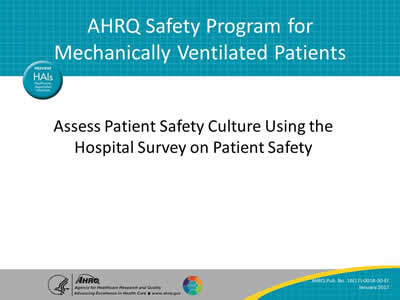
Assess Patient Safety Culture Using the Hospital Survey on Patient Safety
Slide 2: Learning Objectives
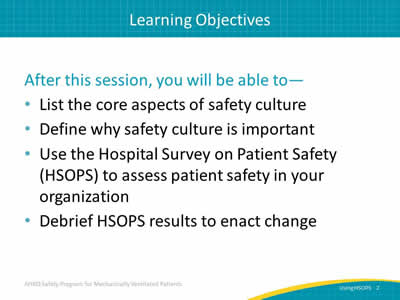
After this session, you will be able to—
- List the core aspects of safety culture.
- Define why safety culture is important.
- Use the Hospital Survey on Patient Safety (HSOPS) to assess patient safety in your organization.
- Debrief HSOPS results to enact change.
Slide 3: What Is Safety Culture?
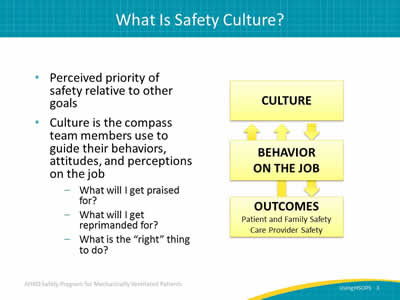
- Perceived priority of safety relative to other goals.
- Culture is the compass team members use to guide their behaviors, attitudes, and perceptions on the job:
- What will I get praised for?
- What will I get reprimanded for?
- What is the "right" thing to do?
Image: Top box (1) is labeled "Culture." Middle box (2) is labeled "Behavior on the Job" and Lower box (3) is labeled "Outcomes." The Outcomes box includes two examples: patient and family safety and provider safety. Arrows connect all boxes to show cycle between culture, behavior on the job and outcome. Culture drives behavior on the job, which contributes to safety outcomes. Those outcomes in turn contribute to behavior on the job and the culture.
Slide 4: Core Aspects of Safety Culture1
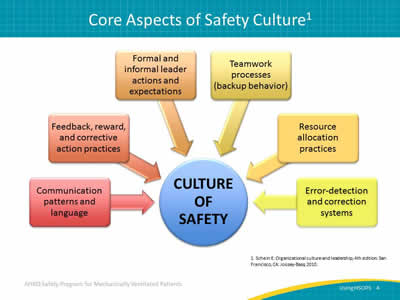
Image: Diagram of a converging radial that outlines six domains of safety culture. The central circle is labeled culture of safety. Surrounding this central circle are six boxes with arrows pointing to the circle. These boxes are labeled:
- Communication patterns and language.
- Feedback, reward, and corrective action practices.
- Formal and informal leader actions and expectations.
- Teamwork processes (e.g., backup behavior).
- Resource allocation practices.
- Error-detection and corrective system.
Based on definitions of culture proposed by Dr. Edgar Schein, MIT Sloan School of Management. Source: Armstrong Institute for Patient Safety and Quality.
1. Schein E. Organizational culture and leadership, 4th edition. San Francisco, CA: Jossey-Bass; 2010.
Slide 5: Model for Improving Care
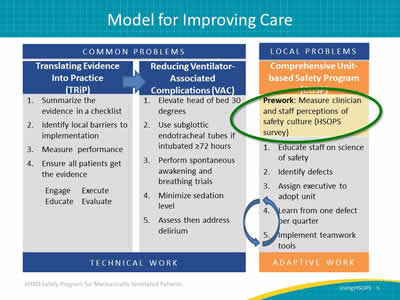
Image: Figure illustrating how to use the TRIP framework to address common problems through technical work and how to use CUSP to address local problems through adaptive work.
Slide 6: Safety Culture Is Related to Outcomes2-7
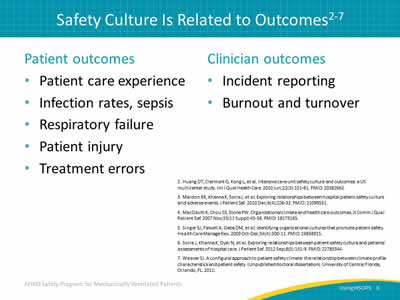
Patient outcomes:
- Patient care experience.
- Infection rates, sepsis.
- Respiratory failure.
- Patient injury.
- Treatment errors.
Clinician outcomes:
- Incident reporting.
- Burnout and turnover.
2. Huang DT, Clermont G, Kong L, et al. Intensive care unit safety culture and outcomes: a US multicenter study. Int J Qual Health Care 2010 Jun;22(3):151-61. PMID: 20382662.
3. Mardon RE, Khanna K, Sorra J, et al. Exploring relationships between hospital patient safety culture and adverse events. J Patient Saf 2010 Dec;6(4):226-32. PMID: 21099551.
4. MacDavitt K, Chou SS, Stone PW. Organizational climate and health care outcomes. Jt Comm J Qual Patient Saf 2007 Nov;33(11 Suppl):45-56. PMID: 18173165.
5. Singer SJ, Falwell A, Gaba DM, et al. Identifying organizational cultures that promote patient safety. Health Care Manage Rev 2009 Oct-Dec;34(4):300-11. PMID: 19858915.
6. Sorra J, Khanna K, Dyer N, et al. Exploring relationships between patient safety culture and patients' assessments of hospital care. J Patient Saf 2012 Sep;8(3):131-9. PMID: 22785344.
7. Weaver SJ. (2011) A configural approach to patient safety climate: the relationship between climate profile characteristics and patient safety. (Unpublished doctoral dissertation). University of Central Florida, Orlando, FL.
Slide 7: Why Safety Culture Matters8-11
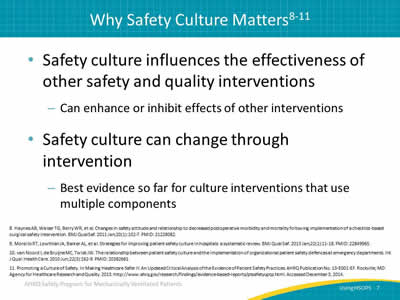
- Safety culture influences the effectiveness of other safety and quality interventions:
- Can enhance or inhibit effects of other interventions.
- Safety culture can change through intervention:
- Best evidence so far for culture interventions that use multiple components.
8. Haynes AB, Weiser TG, Berry WR, et al. Changes in safety attitude and relationship to decreased postoperative morbidity and mortality following implementation of a checklist-based surgical safety intervention. BMJ Qual Saf 2011 Jan;20(1):102-7. PMID: 21228082.
9. Morello RT, Lowthian JA, Barker AL, et al. Strategies for improving patient safety culture in hospitals: a systematic review. BMJ Qual Saf 2013 Jan;22(1):11-18. PMID: 22849965.
10. van Noord I, de Bruijne MC, Twisk JW. The relationship between patient safety culture and the implementation of organizational patient safety defences at emergency departments. Int J Qual Health Care 2010 Jun;22(3):162-9. PMID: 20382661.
11. Promoting a Culture of Safety. In Making Healthcare Safer II: An Updated Critical Analysis of the Evidence of Patient Safety Practices. AHRQ Publication No. 13-E001-EF. Rockville, MD: Agency for Healthcare Research and Quality. 2013. http://www.ahrq.gov/research/findings/evidence-based-reports/ptsafetyuptp.html. Accessed December 3, 2014.
Slide 8: Measuring Safety Culture
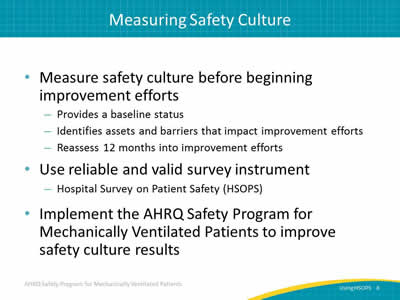
- Measure safety culture before beginning improvement efforts:
- Provides a baseline status.
- Identifies assets and barriers that impact improvement efforts.
- Reassess 12 months into improvement efforts.
- Use reliable and valid survey instrument:
- Hospital Survey on Patient Safety (HSOPS).
- Implement the AHRQ Safety Program for Mechanically Ventilated Patients to improve safety culture results.
Slide 9: What Is HSOPS?
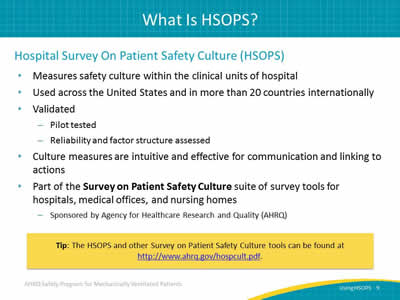
Hospital Survey On Patient Safety Culture (HSOPS):
- Measures safety culture within the clinical units of hospital.
- Used across the United States and in more than 20 countries internationally.
- Validated:
- Pilot tested.
- Reliability and factor structure assessed.
- Culture measures are intuitive and effective for communication and linking to actions.
- Part of the Survey on Patient Safety Culture suite of survey tools for hospitals, medical offices, and nursing homes.
- Sponsored by Agency for Healthcare Research and Quality.
Tip: The HSOPS and other Survey on Patient Safety Culture tools can be found at http://www.ahrq.gov/hospcult.pdf.
Slide 10: HSOPS Dimensions
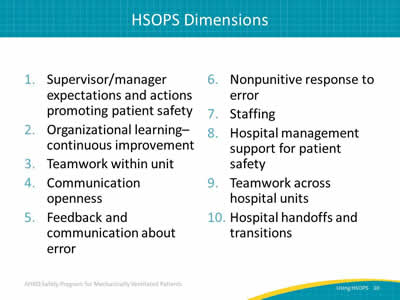
- Supervisor/manager expectations and actions promoting patient safety.
- Organizational learning–continuous improvement.
- Teamwork within unit.
- Communication openness.
- Feedback and communication about error.
- Nonpunitive response to error.
- Staffing.
- Hospital management support for patient safety.
- Teamwork across hospital units.
- Hospital handoffs and transitions.
Slide 11: HSOPS Sample Questions
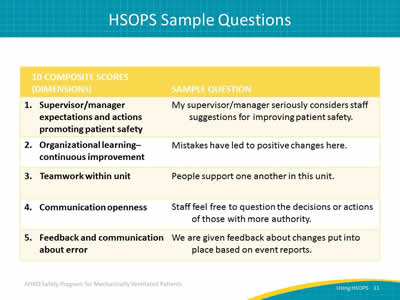
Image: HSOPS sample questions for dimensions 1-5.
Slide 12: HSOPS Sample Questions
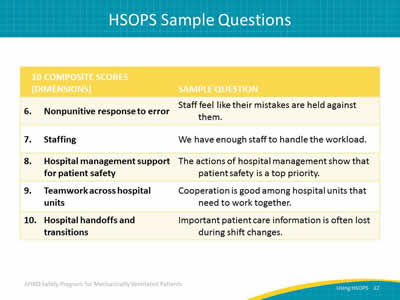
Image: HSOPS sample questions for dimensions 6-10.
Slide 13: HSOPS Sample Questions
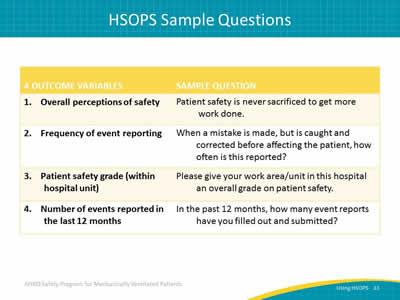
Image: HSOPS sample questions for outcome variables 1-4.
Slide 14: HSOPS Scoring
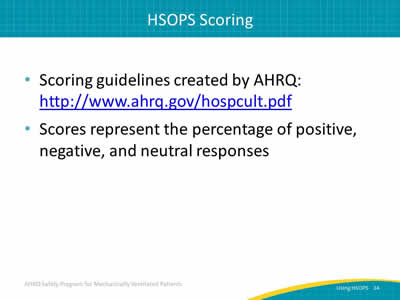
- Scoring guidelines created by AHRQ: http://www.ahrq.gov/hospcult.pdf.
- Scores represent the percentage of positive, negative, and neutral responses.
Slide 15: Effective HSOPS Surveys…
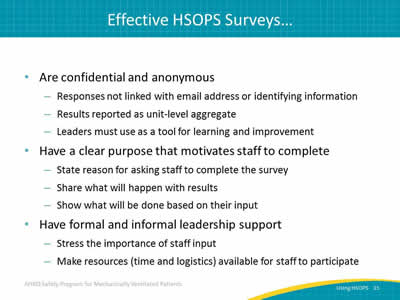
- Are confidential and anonymous:
- Responses not linked with email address or identifying information.
- Results reported as unit-level aggregate.
- Leaders must use as a tool for learning and improvement.
- Have a clear purpose that motivates staff to complete:
- State reason asking staff to complete the survey.
- Share what will happen with results.
- Show what will be done based on their input.
- Have formal and informal leadership support:
- Stress the importance of staff input.
- Make resources (time and logistics) available for staff to participate.
Slide 16: Response Rate Matters
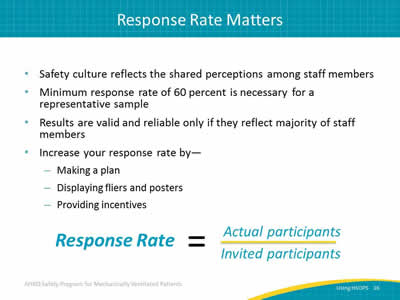
- Safety culture reflects the shared perceptions among staff members.
- Minimum response rate of 60 percent is necessary for a representative sample.
- Results are valid and reliable only if they reflect majority of staff members.
- Increase your response rate by—
- Making a plan.
- Displaying fliers and posters.
- Providing incentives.
Image: Response rate = actual participants divided by invited participants.
Slide 17: Successful Prenotification12
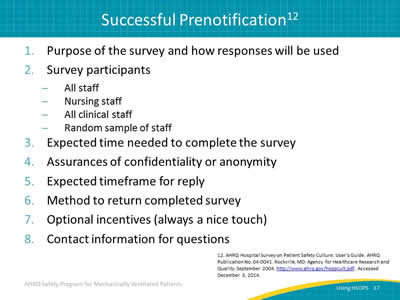
- Purpose of the survey and how responses will be used.
- Survey participants:
- All staff.
- Nursing staff.
- All clinical staff.
- Random sample of staff.
- Expected time needed to complete the survey.
- Assurances of confidentiality or anonymity.
- Expected timeframe for reply.
- Method to return completed survey.
- Optional incentives (always a nice touch).
- Contact information for questions.
12. AHRQ Hospital Survey on Patient Safety Culture: User’s Guide. AHRQ Publication No. 04-0041. Rockville, MD: Agency for Healthcare Research and Quality. September 2004. http://www.ahrq.gov/hospcult.pdf. Accessed December 3, 2014.
Slide 18: Additional Tips for Effective Surveys
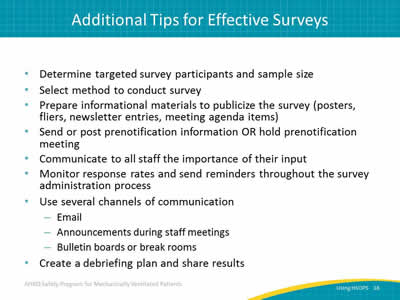
- Determine targeted survey participants and sample size.
- Select method to conduct survey.
- Prepare informational materials to publicize the survey (posters, fliers, newsletter entries, meeting agenda items).
- Send or post prenotification information OR hold prenotification meeting.
- Communicate to all staff the importance of their input.
- Monitor response rates and send reminders throughout the survey administration process.
- Use several channels of communication:
- Email.
- Announcements during staff meetings.
- Bulletin boards or break rooms.
- Create a debriefing plan and share results.
Slide 19: Turning HSOPS Data into Action
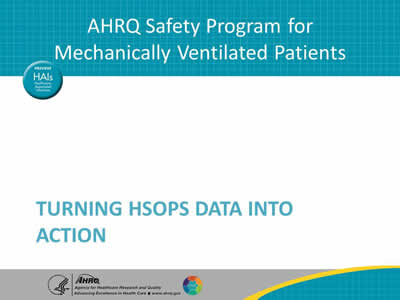
Turning HSOPS Data into Action
Slide 20: What Is Debriefing?
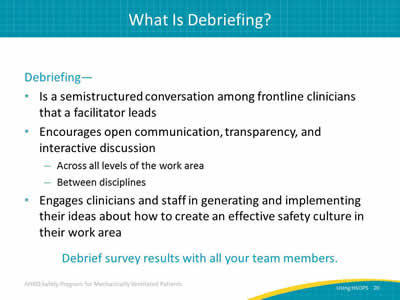
Debriefing—
- Is a semistructured conversation among frontline clinicians that a facilitator leads.
- Encourages open communication, transparency, and interactive discussion:
- Across all levels of the work area.
- Between disciplines.
- Engages clinicians and staff in generating and implementing their ideas about how to create an effective safety culture in their work area.
Debrief survey results with all your team members.
Slide 21: Debriefing—Making HSOPS Data Meaningful13
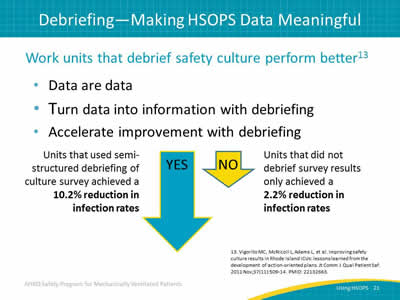
Work units that debrief safety culture perform better:
- Data are data.
- Turn data into information with debriefing.
- Accelerate improvement with debriefing.
Image: Longer blue, down-pointing arrow labeled YES. Shorter yellow down-pointing arrow labeled NO.
Units that use semistructured debriefing of culture survey achieved a 10.2% reduction in infection rates.
Units that did not debrief survey results only achieved a 2.2% reduction in infection rates.
13. Vigorito MC, McNicoll L, Adams L,et al. Improving safety culture results in Rhode Island ICUs: lessons learned from the development of action-oriented plans. Jt Comm J Qual Patient Saf 2011 Nov;37(11):509-14. PMID: 22132663.
Slide 22: Benefits of HSOPS Data
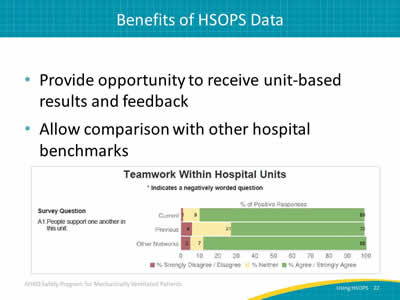
- Provide opportunity to receive unit-based results and feedback.
- Allow comparison with other hospital benchmarks.
Image: Bar graph illustrating the percentage of positive responses to a survey question about teamwork within hospital units.
Slide 23: Questions?

Image: Picture of colored hanging tags with question marks on them.
Slide 24: References
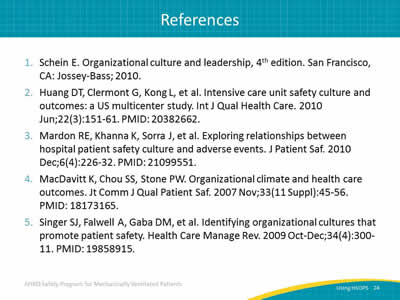
1. Schein E. Organizational culture and leadership, 4th edition. San Francisco, CA: Jossey-Bass; 2010.
2. Huang DT, Clermont G, Kong L, et al. Intensive care unit safety culture and outcomes: a US multicenter study. Int J Qual Health Care 2010 Jun;22(3):151-61. PMID: 20382662.
3. Mardon RE, Khanna K, Sorra J, et al. Exploring relationships between hospital patient safety culture and adverse events. J Patient Saf 2010 Dec;6(4):226-32. PMID: 21099551.
4. MacDavitt K, Chou SS, Stone PW. Organizational climate and health care outcomes. Jt Comm J Qual Patient Saf 2007 Nov;33(11 Suppl):45-56. PMID: 18173165.
5. Singer SJ, Falwell A, Gaba DM, et al. Identifying organizational cultures that promote patient safety. Health Care Manage Rev 2009 Oct-Dec;34(4):300-11. PMID: 19858915.
Slide 25: References
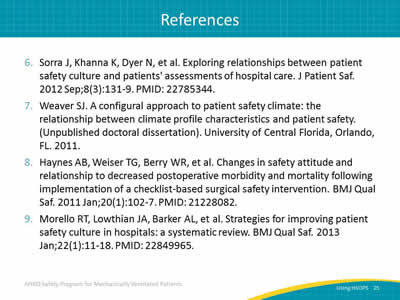
6. Sorra J, Khanna K, Dyer N, et al. Exploring relationships between patient safety culture and patients' assessments of hospital care. J Patient Saf 2012 Sep;8(3):131-9. PMID: 22785344.
7. Weaver SJ. (2011) A configural approach to patient safety climate: the relationship between climate profile characteristics and patient safety. (Unpublished doctoral dissertation). University of Central Florida, Orlando, FL.
8. Haynes AB, Weiser TG, Berry WR, et al. Changes in safety attitude and relationship to decreased postoperative morbidity and mortality following implementation of a checklist-based surgical safety intervention. BMJ Qual Saf 2011 Jan;20(1):102-7. PMID: 21228082.
9. Morello RT, Lowthian JA, Barker AL, et al. Strategies for improving patient safety culture in hospitals: a systematic review. BMJ Qual Saf 2013 Jan;22(1):11-18. PMID: 22849965.
Slide 26: References
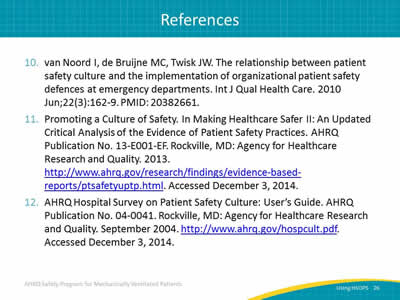
10. van Noord I, de Bruijne MC, Twisk JW. The relationship between patient safety culture and the implementation of organizational patient safety defences at emergency departments. Int J Qual Health Care 2010 Jun;22(3):162-9. PMID: 20382661.
11. Promoting a Culture of Safety. In Making Healthcare Safer II: An Updated Critical Analysis of the Evidence of Patient Safety Practices. AHRQ Publication No. 13-E001-EF. Rockville, MD: Agency for Healthcare Research and Quality. 2013. http://www.ahrq.gov/research/findings/evidence-based-reports/ptsafetyuptp.html. Accessed December 3, 2014.
12. AHRQ Hospital Survey on Patient Safety Culture: User’s Guide. AHRQ Publication No. 04-0041. Rockville, MD: Agency for Healthcare Research and Quality. September 2004. http://www.ahrq.gov/hospcult.pdf. Accessed December 3, 2014.
Slide 27: References
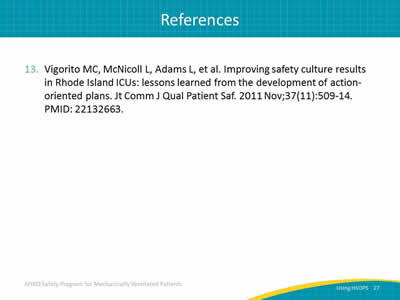
13. Vigorito MC, McNicoll L, Adams L,et al. Improving safety culture results in Rhode Island ICUs: lessons learned from the development of action-oriented plans. Jt Comm J Qual Patient Saf 2011 Nov;37(11):509-14. PMID: 22132663.



